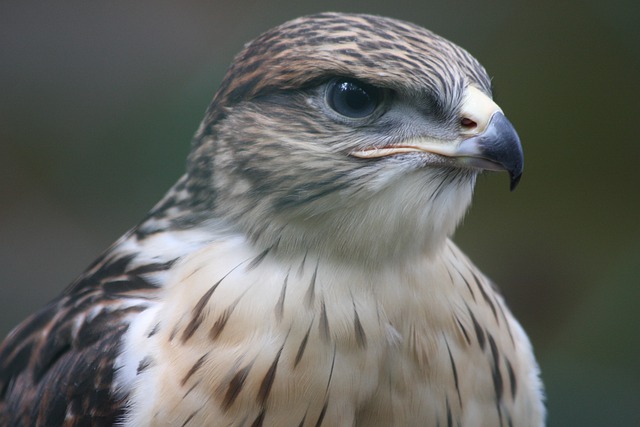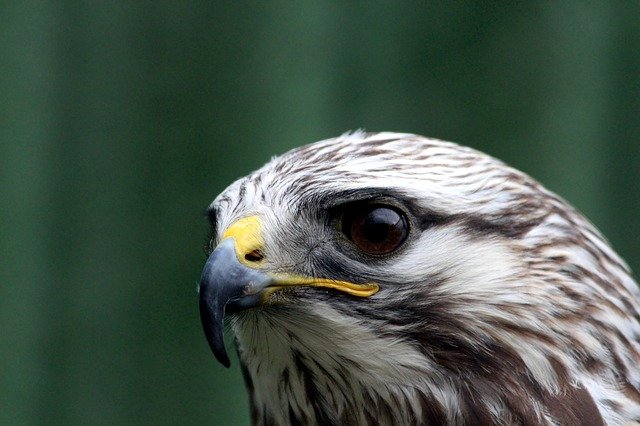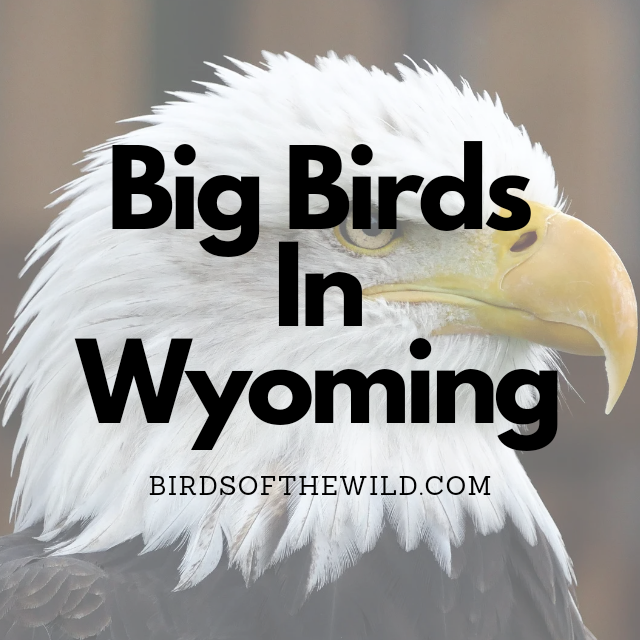Wyoming is home to its fair share of large birds. In this article I’ll particularly be going over 7 unique larger birds that consider the state home so continue reading to learn more about them.
- Bald Eagle
- Golden Eagle
- Great Horned Owl
- American White Pelican
- Sandhill Crane
- Ferruginous Hawk
- Rough Legged Buzzard
7 Big Birds In Wyoming
1. Bald Eagle (Haliaeetus Leucocephalus)

- Size: 90 – 108cm
- Weight: 3 – 6.3kg
- Wingspan: 180 – 250cm
Blad eagles are year round residents in northwestern and some parts of the southern region within Wyoming. As for the remainder of the state, they typically stick around throughout their non-breeding fall and winter months.
A bald eagle’s plumage consists of dark brown around its wing and body, with white feathers on its tail and head along with the trademark yellow beak and feet. Both male and female bald eagles look relatively the same.
As for where you can find these eagles, it will often be around lakes and reservoirs with lots of fish and surrounding forests. You’ll often find them around unfrozen lakes and hunting along coastlines, reservoirs, and rivers during the winter months
These eagles are birds of prey meaning they hunt other birds, medium sized mammals like rabbits, hares, other animals like reptiles, fish and even eat carrion when their options are limited. Sometimes bald eagles are recognised as fish eagles as their diet consists of fish and as meat is the only thing they eat these eagles would ultimately be regarded as carnivores too.
Blad eagles can live for around 20 years in the wild.
2. Golden Eagle (Aquila Chrysaetos)

- Size: 70 – 82cm
- Weight: 3.7 – 5.3kg
- Wingspan: 190 – 212cm
Golden eagles can be spotted in Wyoming on a year round basis.
These eagles are recognised by their mostly light brown and dark brown plumage, yellow feet and black downwards pointing beak. Females once again are the larger of the 2 birds where males are roughly 33% smaller in size.
These eagles spend the majority of their time within open moorlands and mountains within the likes of Scotland, and many areas within north America
Golden eagles do eat carrion but, it isn’t their first choice of food when hunting for prey. If they do find a dead carcass they will eat it, with their general food choices consisting of smaller mammals, birds and sometimes larger prey.
These eagles are known to live for around 14 years in the wild whilst captive are even able stay alive till their early 30’s with the longest observed at 32 years old.
3. Great Horned Owl (Bubo Vrginianus)

- Size: 57 – 63cm
- Weight: 1.4 – 1.5kg
- Wingspan: 1.35 – 1.5m
Great horned owls are year round residents in the state of Wyoming.
These large horned owls are recognised by their brown/gray plumage with their defining feature being the tuft of feather on the top of their head resembling a horn or ear like feature. Male and female great horned owls look relatively the same with the females slightly larger in size.
At night these birds will perch on a branch or a tall building to look around for prey and once the desired prey has been found they will fly towards it with folded wings, grab the prey with their talons piercing through their body and in most cases killing them immediatley.
As for what these birds eat it includes smaller prey like rodents, frogs or scorpions. Even other larger predators like geese, ducks, hawks, and smaller owls can be eaten by these carnivorous birds.
Great horned owls are most commonly found in deserts, wetlands, forests, grasslands, backyards, cities and they can also be found in semi-open habitats between the Arctic and the tropics.
As for a great horned owls lifespan, it can be anywhere from 15 -25 years.
4. American White Pelican (Pelecanus Erythrorhynchos)

- Size: 130 – 160cm
- Weight: 6 – 6.5kg
- Wingspan: 260 – 290cm
American white pelicans can be found in southeast Wyoming when breeding but, in remainder of the state they will typically use it as a migration passage.
These pelicans can be recognised by their mostly white plumage and extremely large bills. Females look vey similar to the males.
You’ll often spot these birds around lakes and rivers.
As for what they eat, it includes mostly fish of the rough kind that humans don’t typically capture, smaller amphibians and crayfish.
Wild American white pelicans are known to live for around 16 year in the wild whilst captive ones are known to be around the 30 – 35 year range.
5. Sandhill Crane (Grus Canadensis)

- Size: 91 – 151cm
- Weight: 2.72 – 6.34kg
- Wingspan: 150 – 190cm
Sandhill cranes will stick around the western border of Wyoming when breeding but, will use the remainder of the state as a passage of migration.
Sandhill cranes whether the lesser or greater variant are recognised by their gray and brown plumage, their long neck and legs as well as the red spot on their face. They also have a jet black beak. Males are generally bigger than the females whilst the females don’t have any red spots near the eyes and beak.
These cranes tend to spend the majority of their time at open habitats within small bogs, marshes, and prairies. They will also build nests within the same areas they inhabit, but ideally would want the area to be isolated.
Sandhill cranes eat mostly seeds, grains, insects and small animals like worms, mice, small birds, snakes, lizards, frogs and crayfish.
These cranes have a lifespan that extends upto 20 years in the wild.
6. Ferruginous Hawk (Buteo Regalis)

- Size: 50 – 64cm
- Weight: 1.3 – 1.6kg
- Wingspan: 134 – 143cm
Ferruginous hawks can be found in most of Wyoming on a year round basis although in some regions around eastern Wyoming they will only stick around when it’s fall or winter.
These hawks are recognised by their rusty orange/light brown wings with black patterned dots near the bottom of their wings, yellow and black beak, orange and black feet, their legs the same color as the wings and lastly a white neck, belly and breast with small amounts of brown nearer the breast and below. Both genders look very similar but the females are larger.
You’ll find ferruginous hawks mainly around open country, including dry prairie, sagebrush, and steppe-deserts with short vegetation containing large populations of small mammals.
As for the type of food they consume, it includes small prey like young jackrabbits, ground squirrels, pocket gophers, kangaroo rats, cottontails, mice etc. Other animals like birds, snakes and large insects are occasionally a part of their diet too.
Ferruginous hawks are known to live for upto 20 years in the wild although most tend not to live beyond the 5 year mark.
7. Rough Legged Buzzard (Buteo lagopus)

- Size: 46 – 59cm
- Weight: 0.6 – 1.3kg
- Wingspan: 120 – 150cm
Rough legged buzzards can be found in Wyoming throughout their fall and winter non-breeding months.
These buzzards are recognised by their brown and white plumage where their wings are brown, their neck and head black and the underside of their belly and wings with elements of brown but, mostly white in color. Females are generally just the larger of the 2.
You’ll often find rough legged buzzards around bogs and mountainous heathland areas, or in clearings in coniferous woodlands.
As for what these buzzards eat, it includes birds, reptiles, amphibians, larger insects among other smaller rodents and mammals.
These hawks can live for around 19 years in the wild.
Amhil Khan, a dedicated nature enthusiast and the founder of BirdsOfTheWild.com, is a passionate advocate for the captivating world of avian wonders. With a deep-seated curiosity about the intricate lives of birds, Amhil’s journey began as a fascination and has evolved into a mission to inspire others to appreciate and protect these magnificent creatures.
Amhil’s love for birds led to the creation of Birds of the Wild, a platform where his expertise in ornithology, coupled with his captivating storytelling, provides readers with an immersive and educational experience. Through his lens and words, he captures the essence of birds in their natural habitats, offering a glimpse into their behaviors, migrations, and the ecosystems they inhabit.

